- Author Curtis Blomfield [email protected].
- Public 2023-12-16 20:44.
- Last modified 2025-01-23 17:01.
Zirconium oxide has a long history of use in dentistry and is distinguished by its strength and compatibility with the natural environment. All this is confirmed by numerous clinical studies.
Benefits of Frames
Zirconium oxide is used to create many structures, in particular, frameworks based on it have amazing accuracy. All this is done thanks to the use of modern medical technologies. Products based on this material are durable, outwardly no one can distinguish an artificial product from real teeth.
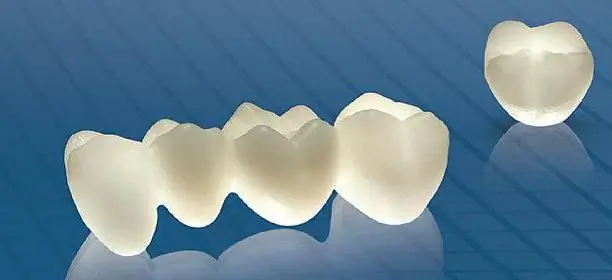
The zirconium oxide frame is lined with a special porcelain mass, which is of natural origin. All this makes the product simply perfect compared to conventional ceramic-metal constructions used in dentistry.
Zirconium oxide inlay, dentures, veneers and bridges are all valued for their durability and biocompatible material.
And the frame based on this material is able to reduce the thickness of the walls of the crowns, respectively, the depth of processing of hard dental tissues also decreases. Thanks to this, the support in the mouth cansave and make the prosthesis easier.
Features of metal-free ceramics
Zirconium oxide is used to create crowns to which aluminum is added. They are also called non-metal. In prosthetics today, they are quite widespread and are distinguished by their high strength. Their main feature is the absence of metal components and high aesthetic design.
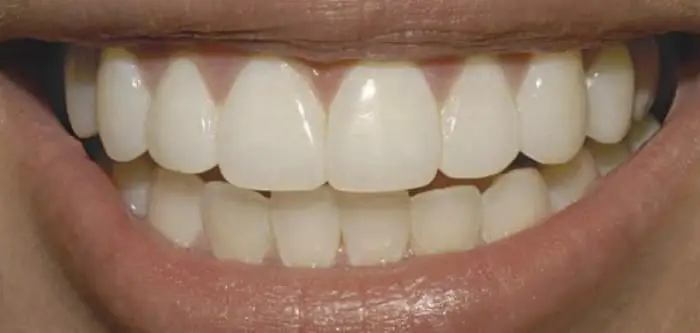
Metal-free crown on zirconium and aluminum oxide is the result of the introduction of modern high technologies in the field of dentistry. It is not only durable, biologically compatible with teeth, but also translucent. Outwardly, no one will think that this is just a crown, it looks so natural.
Creating a metal-free crown
Such ceramics are widely used in the manufacture of not only whole crowns, but also inlays and veneers. If the previously installed fillings have darkened or the old crown has changed color, then the zirconium oxide, which lies at its base, will certainly help to renew them.
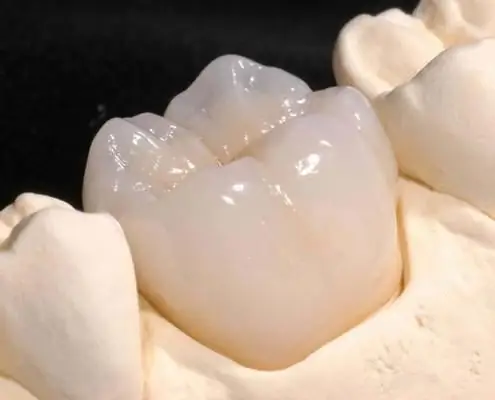
When making a frame, the doctor takes an impression of his patient's dentition, then a wax model is made on its basis. It is scanned and saved to a computer, then to be created in a three-dimensional form and designed taking into account future shrinkage. Then the frame is placed in a special milling machine, where it is machined on the basis of zirconium oxide.
Then the structure is sintered in a furnace, gaining strength. And finally the frameworkveneered with ceramic mass. As a result, biocompatible dental crowns are obtained, zirconium oxide plays an important role in this characteristic.
Imitation
Zirconium oxide prostheses in most cases are perceived positively by the human body. They are durable and reliable, there is no risk of rejection and infection.
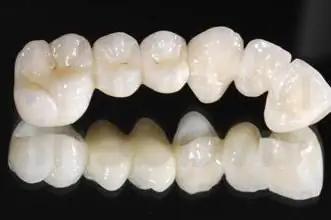
Imitation of natural teeth is achieved due to the fact that the zirconium oxide compound has a white tint. When installing a ceramic-metal crown, this cannot be obtained, since the frame of the structure will have a metallic color. And so that the metal does not shine through the ceramics, the crowns are equipped with a special coating. As a result, such prostheses do not transmit light, and there is no color depth in them. The gum is not illuminated from the inside, as in its natural form, and the presence of a foreign body in the mouth becomes apparent.
Advantage of automatic production mode
Moreover, a metal-free crown is made using a special technology, which is completely different from manual casting of ceramic-metal products. All processes are carried out automatically.
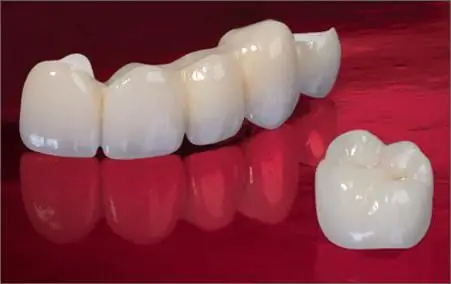
The permissible gap between the prosthesis and the tooth itself can be from 100 to 300 microns. By means of the latest technologies used in the creation of products from zirconium oxide, it has been reduced to 30 microns. This means maximum precision in the connections between teeth and prosthesis.
Bridge making
Even this specific type of prosthesis can be madewithout metal frame. A bridge made of zirconium oxide can also be made, but it will not be able to have a large length, like a regular one. Its frame, unlike metal, will be transparent.
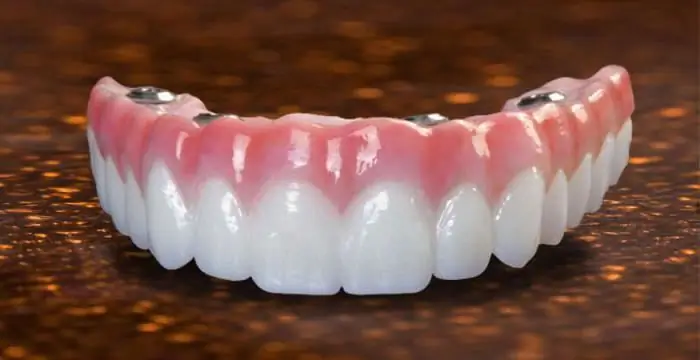
Also, zirconium oxide can be used during implant prosthetics if the patient needs a high level of aesthetics. And, as mentioned earlier, it can be used to make any kind of prosthesis.
Outside
One of the key benefits of zirconium oxide crowns is their natural appearance and attractiveness. If ceramic-metal prostheses always have a characteristic shade, then in this case it can be selected at the level of the framework in order to completely imitate the color of the patient's teeth. Regardless of the type of lighting, the tooth will remain transparent. In addition, unlike metal, which tends to darken and deform over time, zirconium oxide will remain the same even for many years.
Also, many often complain about the discoloration of the gums next to metal-ceramic crowns. This happens due to the fact that the frame of the structure negatively affects the tissues located next to it. Of course, the gums do not turn red or become cyanotic in all cases, but quite often. Prostheses using zirconia will completely eliminate this phenomenon.
Compatibility
Zirconium oxide is good because it has a hypoallergenic property. Before this material was used in dentistry, it was often used inmanufacturing heads for hip prostheses to increase their strength.
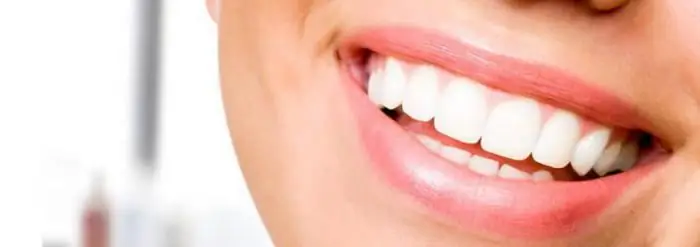
Allergic manifestations in patients when installing artificial teeth or inlays usually occur quite often. Moreover, such reactions can be present even with the use of noble types of metal (gold, platinum, palladium, and others). For many allergy sufferers, zirconium oxide crowns or bridges are the only possible solution to improve their teeth.
Often the problem and sensitivity of the teeth. During prosthetics, such a phenomenon can interfere with the installation of everything you need. So, when installing crowns without the use of metal, the sensitivity threshold noticeably changes for the better. All this is due to the fact that zirconium oxide is an excellent natural heat insulator and is able to protect teeth from temperature extremes. If a stump tab is made on its basis, the patient will not be subject to thermal irritation.
Other material advantages
Zirconium oxide is partially enriched with aluminum and stabilized by yttrium, which subsequently makes products based on it strong and light. In addition, when microcracks appear on the surface, the surface structure is self-healing at the molecular level.
Zirconium crowns are made not only on the front teeth, but also on the side teeth.
This material, among other things, is considered the most ideal for fixing the bite height. It has no porosity, unlike cermets, thereforeantagonist erasure is lower.
And the fact that anatomical crowns can be milled allows profile specialists to successfully use them during prosthetics using counter crowns that fix the bite height.
Processing of hard dental tissues when installing metal-free prostheses is minimal. The zirconium oxide dental framework is only 0.4 mm thick. Thanks to this, it is possible to minimally grind them and even make prosthetics of the living.
Disadvantages and contraindications
Like any other product used for dental purposes, zirconium oxide prostheses have their own contraindications. Although in this case there are only two of them, which are not so common:
- bruxism;
- pronounced deep bite.
In other cases, you can install crowns, even if the patient brings a certificate of allergy to some components of the prosthesis. It will not apply to non-metal.
As for the disadvantages of products based on zirconium oxide, they are virtually non-existent. However, the key and only one is their high cost. Such a price is formed not only due to the use of certain components, but also the complexity of manufacturing the crown. Here, the technician must have a high level of skill and be trained in a special technique at a high level.
If a patient does not have funds for an expensive product based on zirconium oxide, then he can be offered its budget option based onglass processing. Crowns that are stabilized with yttria are much more expensive.
As you can see, modern developments in the field of dentistry can significantly improve the lives of those who need dentures and do not tolerate them well.






